Journaling with Words and Images
This is the fourth and final interview in a series of interviews with Joan Gregory about Art Journaling. It’s been some time since the last post; thanks for hanging in there!
Once you have a sense of the way you can explore your experience with journal work, are there ways you can shape the process to take yourself in a specific direction?
Yes, there are ways to shape the process. For example, in 2005 I wanted to be in a place of gratitude. Looking back at my journal I could see that there was still a fair bit of whining going on, and I decided to only write about the things I was thankful for. It does have value to do that; it reframes how you look at your day. It’s not that you deny that the bad stuff is happening; it’s just that you are not choosing to write about it in that journal.
One thing to do, whether you are journaling on a scrap of paper or in several books, recording dreams, poetry, or other writing, is always date your entry. A really interesting thing to do is cross-reference the entries after a bit of time has passed. It’s lets you see how all the different pieces are fitting together.
Thinking about dating, makes me think it would be interesting to do that with quotes as well. I’ve collected quotes, but I haven’t noted when I found them. Time can become so fluid; something that happened twenty years ago can feel like it only happened five years ago.
Some things like web pages or magazine articles have dates on them, but for anything else that you collect, that doesn’t have a date, yes date that too. I even like to write the date I’ve gotten a book in the book. As well, when I buy books, I’ll note the titles in my journal, another way to document what interests me at a particular stage of my life. Then later, as you go back through your journal(s) you can see, “oh, this is what I like, this is what resonates with me, what has meaning”. These are just more l clues along your path to determine who your true self may be.
Are there books or articles about journaling that you feel have been helpful?
One of the articles I’ve kept is called, “Leaving a Trace”; an excerpt from a book by Alexandra Johnson called Leaving a trace: On Keeping A Journal. It’s examines the answer to the question, “why am I keeping a journal?” This is an interesting question to ask yourself, and to explore in your journal. It will likely lead to other areas to delve into. Is it to leave something for my children and grandchildren? Is a place for me to reflect on my life and experience? Is it just for the pleasure of creating something personal?
There are so many resources on journaling available in different formats. There are ‘how to ’books, memoirs and diaries of well-known writers, articles in various magazines and on the internet. It is really difficult to limit it to a few. However, in addition to those I have already mentioned in previous segments of this interview, I have found these to be inspiring.
Life’s Companion: Journal Writing as a Spiritual Practice by Christina Baldwin
Writing For Your Life: A Guide and Companion to the Inner Worlds by Deena Metzger
Creative Journal Writing: the Art and Heart of Reflection by Stephanie Dowrick
I have already referenced Ira Progoff’s Intensive Journal Workshop. The next best thing to attending a workshop would be to read the book, At a Journal Workshop: Writing to Access the Power of the Unconscious and Evoke Creative Ability. I have attended one of the courses and highly recommend the experience, especially if you seek guidance from, and connection to, your inner life. It definitely deepens and broadens your journal work. A favourite answer to the question, “Why do you journal” comes from this book: “To interact with your life”.
There is an upcoming Journal Workshop in Edmonton in late July/early August. You can go to their website to read more about the process and to get further details on workshops in your area.
I think we’ve all gone through periods where things can seem flat; where nothing seems to be catching your attention; times when you feel like there is nothing to write or say; times when It all seems dry. What can you do when you come to your journal and there is nothing to put on the page?
Whether you are a poet, a writer or an artist, you have to first be an observer, a wonderer, and a collector; not so much a collector of things as a collector of impressions. Begin to bring a child-like curiosity to the way you explore. If you can meet your journal page everyday with that openness, with not knowing, as if you had never seen a day before, as if you had just arrived, you will bring presence and freshness to the page.
To take it another direction, resurrect the lost art of pretending that we experienced as children. Allow yourself to become a fictional or historical character moving through your day. What would you see if you were say, Alice in Wonderland, or Anais Nin? Use your imagination to view your world from a different perspective and write about it.
You could also imagine yourself twenty years from now. As you look back from the future, who do you see sitting there writing? What is her world like, what are her hopes and fears? This is another way of recognizing who you are in the world.
Do you find that the Art Journal process opens the journal process up?
Yes, it engages more of your senses and provides a way to use all the ephemera of your life. Throughout the day you encounter news stories, tickets, stamps, ads, magazine pictures and more, and if you are open to these they can find their way into your journal to document your day. So you end up seeing more, and finding more beauty in every day. Each day you encounter endless possibility for story. From the simplest thing, like seeing a fallen leaf on the ground in the fall, to seeing an older woman walking up the street using a walker, we are bombarded by story potential. If you are open to receiving, there’s no limit to what you can write about. If you feel a bit overwhelmed, pick the top three things that stood out for you that day, choose one and reflect on it.
Why did that capture my interest today?
What’s going on that I would recognize this one thing as significant?
You can use these questions as a starting point.
Have you ever used your journal to help you make a decision? I’ve sometimes done that by fully imagining where different decisions lead.
I could have used that thirty years ago! Yes, you can use your imagination to gain access to guidance. Ira Progoff uses what he termed ‘twilight imagery’ (similar to Jungian active imagination) in the journal process as a vehicle to access a ‘deeper-than-conscious’ level of ourselves when at a crossroad where a decision has to be made. The technique is used to explore the possibilities of both the ‘roads taken and of the roads not taken’; to provide a self-generated inner knowing and affirmation, as well as the resolution and energy to carry that decision out.
What gifts has the process of writing, rereading, and reflecting in your journal brought you?
The surprises are, as you reread, the realization that you already knew something that you feel you are just now learning, or discovering something that you know you wrote that somehow makes you think you found it a book, it’s that profound. The biggest gift is learning about who you are and acknowledging how much wisdom you actually have. We all have these gems of knowledge buried within. The journal mirrors you to yourself enabling you to see aspects of yourself that you weren’t aware of, or that you didn’t give yourself credit for. You begin to trust yourself more.
Some mornings I’ll take time to go back over the same date in the previous four or five journals to see what I wrote there. Often I will find very similar passages to those I am currently writing and think that I haven’t moved an inch in terms of personal growth, but this repetition is common in journaling. Published journals have similar entries edited out, but there is merit in what at first appears superfluous.
I love what Joseph Campbell, best known for his work in the field of comparative mythology, has to say on the topic. “I brought out my book, Myths to Live By, by collecting together a series of lectures that I had given over a period of twenty-four years. My notion about myself was that I had grown up during that time, that my ideas had changed, and, too, that I had progressed. But when I brought these papers together, they were all saying essentially the same thing – over a span of decades. I found out something about the thing that was moving me. I didn’t even have a very clear idea of what it was until I recognized those continuities running through that whole book. Twenty-four years is a pretty good stretch of time; a lot had happened during that period. And there I was babbling on about the same thing. That’s my myth in there.”
He continues by saying, “Another astonishing way to look back is to pick up some diary entries or notes that you kept a long time ago. You’ll be astonished. Things that you were convinced you had realized more recently will be all pinned down there. These are driving themes in your life”.
And in support of journal writing he adds, “But what if you want to gain some idea of what your myth is while you are living it? Well, another way to try to discern your destiny – your myth – would be to follow Jung’s example: observe your dreams, observe your conscious choices, keep a journal, and see which images and stories surface and resurface. Look at stories and symbols and see which ones resonate.” (The above quotes are taken from page 112 of Pathways to Bliss, Mythology and Personal Transformation by Joseph Campbell, Collected Works Series)
Is there a difference between the Joan on the page and Joan the person?
When I communicate with other people I generally filter what I say to accommodate how I feel the other person will receive it. I think most of us do some form of this. In my journal I am as authentic as I can be. It is a place to be real and true to oneself. If you aren’t going to be honest you won’t receive the mirror’s gift back, or what you do receive will be distorted. You might go back and come to sections that have not been written in your voice, and then begin to explore whose voice it is.
Journal work is a way of removing the layers that have accumulated and gradually exposing one’s true self. It can be a way of getting off the same old track, going deeper than those circular ways of thinking that lead us back to the same spot without more insight. You have to stop and be reflective.
Journal writing takes you along that boundary between the inside and the outside of your life; a very creative place. It allows you to play and to develop some gentleness with yourself. Art journaling also offers some softness to the process and the materials provide another dimension.
Where can someone go to learn about art journal making and to meet others who share art journal interests?
I have mixed feelings about that, based on my own experience. When I started journaling it was all self-discovery; I am self-taught. So, I don’t think you need to go out and buy a book on it, and I didn’t do that until I was some years into it, and wanted to branch out a bit. As with journaling, resources for art journaling are abundant, dare I say, excessive. Only if you truly believe you don’t have a creative bone in your body would I recommend a book. It’s great to start on your own because you will get a sense of your own style.
The book I would recommend is The Decorated Page by Gwen Diehn because it is so full of doable ideas. It’s a great book to use by following her instructions to a T, or to simply take one or two techniques to try. This book is now only available used, but a newer book, also by her, is The Decorated Journal: Creating Beautifully Expressive Journal Pages is available in paperback and hard cover.
Stampington & Company offers many publications for artists and crafters. Art Journaling is one publication that will interest journal makers.
Another one of their publications, Somerset Press – The Art of Paper and Mixed Media, also contains articles and tips for journaling. Also, if you’re looking to pursue art journaling in a group setting, Teesha Moore, founder of the annual Artfest held in Port Townsend Washington, created Journalfest last October. Her website has information about events.
Creative souls run amok on the Internet, offering blogs, how–to videos, forums and classes. While these magazines and websites are full of wonderful work that can be inspiring in moderation, I would exercise caution. There is such a thing as too much, and that can bring on sensory overload! Instead of fanning the embers of a newfound creative spark they will more likely douse it! Volumes of ideas can prove overwhelming and intimidating. It can be easy to talk yourself out of starting when you compare yourself to artists who have already been working for years. You too may know the voice that pops up and says, “I’ll never be able to do anything like that.”
What actually happens is the more you do the better you get. The more you do, the more playful you become and the less seriously you’ll take any one piece of work. You discover happy accidents and a sense of fun. Getting yourself going and doing is the main thing. The work shows the way. As you are writing and collecting and cutting and pasting and fooling around with lettering, something else enters your mind, you make a connection, “oh, I could put that with that”, that you wouldn’t have made just by thinking about it. That way you develop from your work and you gain confidence in your own abilities and intuitions without reference to someone else. Referring to someone else’s work is like having training wheels on a bike; you have to take them off in order to know you can ride.
You can’t compare your first work with those who have been art journaling for awhile already. Remember that you are making comparisons to their published work. They went through the learning curve just as you may be doing now, only you don’t see their first attempts, just the end result. You have to be willing to be a beginner.
As this is our final session do you have any parting words?
One of the most intriguing visual depictions of a journal is in the film, The English Patient, based on the novel by Michael Ondaatje. It is used as a thread tying together much of the story. The journal is actually a copy of Histories by Herodotus, regarded as the father of history and credited as the first to see many different stories as part of a single whole story. Almasy, the lead character and owner of the book is never without it. His journal entries are written in the margins and empty pages and it is layered with sketches, maps and photographs he has pasted into it. He calls it his ‘commonplace’ book but values it as a prize possession and his ‘historie’ is his companion throughout his life. That pretty much sums up the essence of a great journal.
Joan has provided some PDFs of art journal pages to get you started. She also makes wonderful greeting cards. You can contact her at Izzy Elly Paper Design, Box 8616, Canmore, AB T1W 2V5, Canada, for information about her cards and her work. Her blog is, “Finding the Questions”
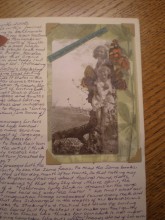
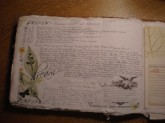
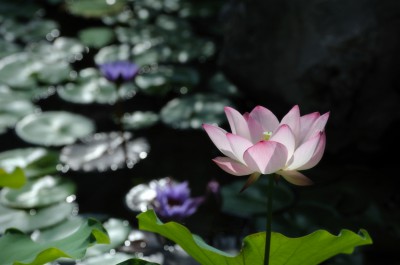
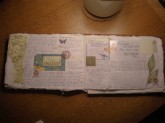 Initially I would write and then add an image or highlight a passage with color. Then, as I mentioned, I would prepare pages ahead of time so I could just fill in the blanks later with writing, but now I’ll go back and forth between the two approaches. You never want to get to a place where you‘re not writing (and I have been there) because you haven’t got a visually attractive page ready yet. I think it’s important to know that you can always go back to a page at a later date and add ‘stuff’.
Initially I would write and then add an image or highlight a passage with color. Then, as I mentioned, I would prepare pages ahead of time so I could just fill in the blanks later with writing, but now I’ll go back and forth between the two approaches. You never want to get to a place where you‘re not writing (and I have been there) because you haven’t got a visually attractive page ready yet. I think it’s important to know that you can always go back to a page at a later date and add ‘stuff’.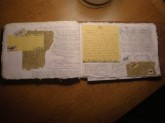 To get you thinking differently about the white page, try sectioning it off into quadrants changing the size of each ‘box’ for interest’s sake. Write in one, color one or two, draw or add images to the other. Use rubber stamps to add an individual graphic or an allover background pattern. Take several pieces of your favorite papers, rip or cut them and paste them onto the page. Embellish with rub on transfers which are still a favorite of mine and can be found at any shop that carries scrapbooking supplies.
To get you thinking differently about the white page, try sectioning it off into quadrants changing the size of each ‘box’ for interest’s sake. Write in one, color one or two, draw or add images to the other. Use rubber stamps to add an individual graphic or an allover background pattern. Take several pieces of your favorite papers, rip or cut them and paste them onto the page. Embellish with rub on transfers which are still a favorite of mine and can be found at any shop that carries scrapbooking supplies.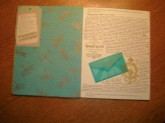 I met Joan in a course I was taking. One day she happened to bring her journal to class which was filled with quotes, drawings, and collage as well as writing and notes. Several of us were interested enough that she agreed to do a short workshop for us before the class started one day. In the workshop we learned how to make a simple book and how to work with special papers and decorative elements. I loved it and asked her to talk to me more about this type of work, Art Journaling.
I met Joan in a course I was taking. One day she happened to bring her journal to class which was filled with quotes, drawings, and collage as well as writing and notes. Several of us were interested enough that she agreed to do a short workshop for us before the class started one day. In the workshop we learned how to make a simple book and how to work with special papers and decorative elements. I loved it and asked her to talk to me more about this type of work, Art Journaling.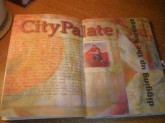 Sure, there is a really obvious turning point in my first journal, on the page and in my mind. It occurs on the fourteenth entry. I had been leaving blank spaces so I could go back and add something to the page, and realized that I didn’t enjoy working on blank white pages at all. For a lot of people the blank page is intimidating, it almost questions your ability to place anything significant on it. So I realized that by adding color or an image it instantly became more inviting and accepting to words.
Sure, there is a really obvious turning point in my first journal, on the page and in my mind. It occurs on the fourteenth entry. I had been leaving blank spaces so I could go back and add something to the page, and realized that I didn’t enjoy working on blank white pages at all. For a lot of people the blank page is intimidating, it almost questions your ability to place anything significant on it. So I realized that by adding color or an image it instantly became more inviting and accepting to words.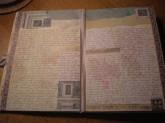 Actually, the process was working me. In the beginning I was really trying to find a form, some kind of venue for expression and that naturally evolves over time and with continued effort. You might refer to the extras that I started including on the pages as ‘visual aids’ for they guide you often into writing about something you may not have planned for that day. These entries become the happy and revealing accidents. For example a photograph of autumn leaves may inspire a memory of a childhood Thanksgiving or the photo of a recently read book jacket recalls something to mind that the author wrote that resonated with you. Even placing a quote in a ready-made box created by your use of attached images can be a jumping off point for your writing. By writing and doing ‘art’ in this manner I committed to the journal process, whether I realized it or not.
Actually, the process was working me. In the beginning I was really trying to find a form, some kind of venue for expression and that naturally evolves over time and with continued effort. You might refer to the extras that I started including on the pages as ‘visual aids’ for they guide you often into writing about something you may not have planned for that day. These entries become the happy and revealing accidents. For example a photograph of autumn leaves may inspire a memory of a childhood Thanksgiving or the photo of a recently read book jacket recalls something to mind that the author wrote that resonated with you. Even placing a quote in a ready-made box created by your use of attached images can be a jumping off point for your writing. By writing and doing ‘art’ in this manner I committed to the journal process, whether I realized it or not.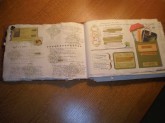 It’s the concept of the third person. When two people talk, there’s a third presence that’s added to the conversation, and an awareness that’s different. There are possibilities that open up in dialogue, whether you are dialoging with your own experience on the page, or in dialogue with another about journaling. An interesting sidebar here is that the administrative headquarters for Ira Progoff’s materials on the Intensive Journal Process is called
It’s the concept of the third person. When two people talk, there’s a third presence that’s added to the conversation, and an awareness that’s different. There are possibilities that open up in dialogue, whether you are dialoging with your own experience on the page, or in dialogue with another about journaling. An interesting sidebar here is that the administrative headquarters for Ira Progoff’s materials on the Intensive Journal Process is called 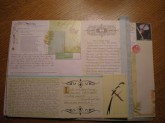 It’s been very encouraging. I go back to those journals and see the underlying need to find purpose and make sense of things in my world; I also see the uncertainty and doubts. Some of the questions and the concerns are similar to what I currently write about and I have moments where I wonder if anything has changed at all over the years. Yet it has. I am standing in a different place now. I see that person as someone who was just beginning to make a conscious choice to acknowledge an inner life as being instrumental in having an effective outer life. She was someone who didn’t yet grasp the power of keeping a journal as a form of guidance but was aware enough to want to commit to documenting her unfolding life. All lives unfold but unless you have an exceptional memory and can relive past feelings accurately, it’s difficult to pinpoint growth unless it is written somewhere. It’s like reading a letter you wrote from long ago and a memory you thought you’d lost is found. But you needed the letter to trigger the memory. Journal writing is such a trigger. They are the letters you write to yourself.
It’s been very encouraging. I go back to those journals and see the underlying need to find purpose and make sense of things in my world; I also see the uncertainty and doubts. Some of the questions and the concerns are similar to what I currently write about and I have moments where I wonder if anything has changed at all over the years. Yet it has. I am standing in a different place now. I see that person as someone who was just beginning to make a conscious choice to acknowledge an inner life as being instrumental in having an effective outer life. She was someone who didn’t yet grasp the power of keeping a journal as a form of guidance but was aware enough to want to commit to documenting her unfolding life. All lives unfold but unless you have an exceptional memory and can relive past feelings accurately, it’s difficult to pinpoint growth unless it is written somewhere. It’s like reading a letter you wrote from long ago and a memory you thought you’d lost is found. But you needed the letter to trigger the memory. Journal writing is such a trigger. They are the letters you write to yourself.
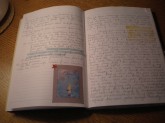
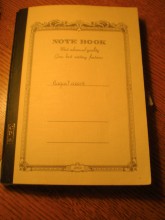 When you start it’s important to pick something for your journal that’s pleasing to you. Your words are a gift to yourself and you want to wrap them in something special. What drew me to my first journal were the black and cream graphics, the quality of the paper, and the cover, which encouragingly says, “Notebook – Most advanced quality Gives best writing features”. It reminded me of the scribblers that were handed out at the beginning of each new subject in elementary school. They too were cream and they had a maple leaf on the cover, the times table was on the back. The pages were smooth, they smelled of fresh ink. It was a real sensory experience and there was anticipation and excitement about what I would be learning. This time though the subject would be me. I wanted to treat my writing seriously; I wanted to treat my thoughts with respect.
When you start it’s important to pick something for your journal that’s pleasing to you. Your words are a gift to yourself and you want to wrap them in something special. What drew me to my first journal were the black and cream graphics, the quality of the paper, and the cover, which encouragingly says, “Notebook – Most advanced quality Gives best writing features”. It reminded me of the scribblers that were handed out at the beginning of each new subject in elementary school. They too were cream and they had a maple leaf on the cover, the times table was on the back. The pages were smooth, they smelled of fresh ink. It was a real sensory experience and there was anticipation and excitement about what I would be learning. This time though the subject would be me. I wanted to treat my writing seriously; I wanted to treat my thoughts with respect.